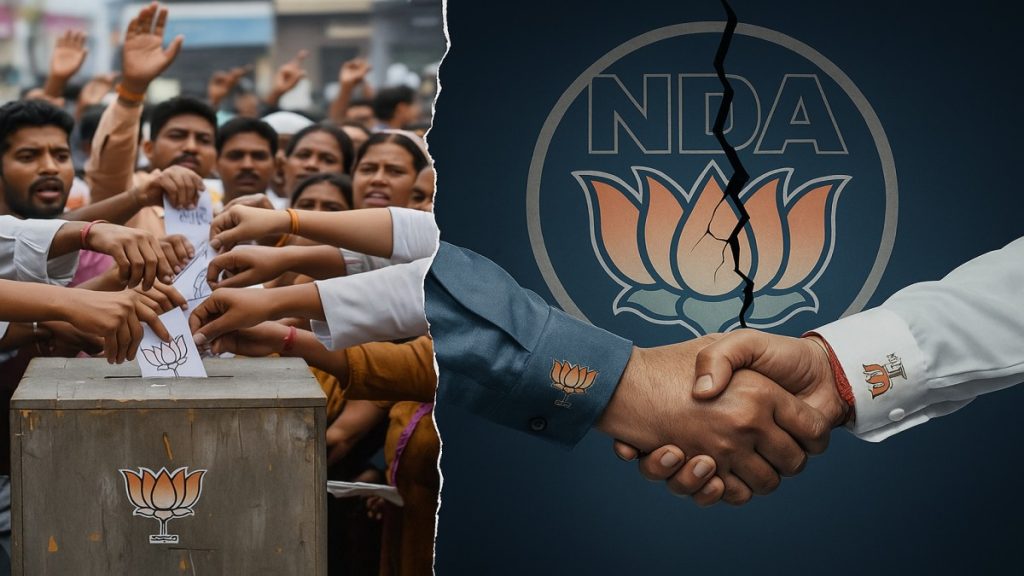
The political landscape of Bihar is once again dominated by intense internal negotiations as the National Democratic Alliance (NDA) prepares for the crucial Bihar Assembly Election 2025 seats. A major flashpoint has emerged following an assertive move by the Lok Janshakti Party (Ram Vilas), led by the dynamic young leader Chirag Paswan. The party has officially staked its claim, delivering a significant jolt to the coalition equilibrium by demanding a large chunk of the total seats.
In a move that could redefine the terms of the Bihar NDA seat sharing 2025 agreement, LJP(RV) has requested a staggering 26 seats, a figure that is immediately raising eyebrows and setting the stage for a tense stand-off. This bold Chirag Paswan demand is not just about numbers; it’s about political assertion, leverage, and staking a substantial claim on the state’s future governance, even challenging the sitting constituencies of its senior alliance partners.
The internal rumblings within the coalition highlight the inherent complexities of seat sharing in Bihar elections. The outcome of these negotiations will not only determine the internal strength of the NDA alliance Bihar 2025 but also dictate its chances against the formidable Mahagathbandhan opposition.
Key takeaways from this escalating political saga:
- The Lok Janshakti Party (Ram Vilas) has formally demanded 26 seats in the NDA for the upcoming 2025 Assembly elections.
- This demand includes several constituencies currently represented by MLAs from the Bharatiya Janata Party (BJP) and the Janata Dal (United) (JD(U)).
- Chirag Paswan has been fully authorized by his party’s parliamentary board to conduct the high-stakes negotiations and finalize the ultimate seat allocation with the NDA leadership.
The Core of the Conflict: Chirag Paswan’s Audacious Demand
The immediate tension stems directly from the sheer scale of the LJP seat demand in NDA. Twenty-six seats in a 243-member assembly, when distributed among four or more coalition partners (BJP, JD(U), LJP(RV), and HAM(S)), represents a significant portion and is perceived as an ambitious power grab. This figure, articulated by the party’s parliamentary board, signals that Chirag Paswan’s LJP (Ram Vilas) is no longer content to play a minor supporting role but aims to be a substantive pillar of the alliance.

This Chirag Paswan demand has a two-fold significance. Firstly, it establishes the party’s perceived strength and its claim based on the momentum gained from the recent Lok Sabha polls and Chirag Paswan’s rising popularity, especially among the Paswan community (Dalits) and youth. Secondly, the party has not limited its ambitions to traditionally LJP-held seats or new territories.
The Lok Janshakti Party demands are uniquely challenging for the senior partners because they reportedly include several sitting seats of both the BJP JDU seat distribution. The source confirms that the list of preferred constituencies discussed by the LJP(RV) parliamentary board specifically names several segments currently held by the BJP and the JD(U), along with a few from Jitan Ram Manjhi’s Hindustani Awam Morcha (Secular) (HAM(S)).
This inclusion of sitting seats is the primary catalyst for the burgeoning seat sharing dispute BJP JDU LJP 2025 Bihar. Typically, in coalition politics, there is an unwritten rule to respect the sitting seats of alliance partners to minimize internal friction and prevent local-level revolts. Chirag Paswan’s strategy to contest this convention underscores his confidence in his party’s ability to win those seats and his willingness to exert maximum pressure on the NDA seat allocation Bihar process.
Read Also: Bihar Voter List Error: 5 Villagers Forced to Plead, "Sir, We Are Alive" Breaking News
Analyzing the 26-Seat Tally: A Calculated Risk
For an understanding of how many seats demanded by LJP in NDA Bihar 2025, one must look beyond the number itself and analyze the underlying political calculation. The 26 seats represent approximately 10.7% of the total Assembly strength. In the context of a four-party Bihar political alliance seat sharing, this is a substantial ask.
Chirag Paswan’s political strategy, often dubbed ‘Bihar First, Bihari First,’ hinges on his perceived connection with the youth and the promise of a revitalized state. By demanding 26 seats, he attempts to solidify his image as a powerful, independent-minded leader who negotiates hard for his party’s future. The number 26 likely encompasses constituencies where the LJP (Ram Vilas) has demonstrated a strong, dedicated vote bank, particularly across the state’s central, northern, and eastern regions.
This high demand is likely a starting point in a classic negotiation, where the final agreed-upon figure is expected to be lower but still significantly higher than what any previous iteration of the LJP received while in the NDA. Political analysts suggest the final tally might settle somewhere between 18 and 22 seats, but only after grueling discussions among the top leadership of all the constituents.
The NDA Power Matrix: BJP, JD(U), and Allies
The NDA alliance Bihar 2025 is currently a complex four-way marriage, primarily involving the Bharatiya Janata Party (BJP), the Janata Dal (United) (JD(U)), the Lok Janshakti Party (Ram Vilas) (LJP(RV)), and the Hindustani Awam Morcha (Secular) (HAM(S)). The relationship between the two senior partners, the BJP and JD(U) and their chief ministers, has been historically volatile, marked by periods of alliance, separation, and reconciliation. The recent realignment of the JD(U) with the NDA has added a layer of stability but also introduced the question of BJP JDU seat distribution after their own separate demands are met.
The BJP, as the dominant national party and the largest single entity in the state, will naturally demand the lion’s share of the Bihar assembly election 2025 seats. The JD(U), relying on its state-level machinery and the legacy of its Chief Minister, is also expected to fight hard to maintain its existing footprint, fearing that a smaller number of seats could further dilute its political capital. This inherent tension between the two majors forms the backdrop against which the LJP’s demand is being pitched.
The entry of a revitalized LJP(RV) under Chirag Paswan, post-2024 Lok Sabha success, fundamentally alters the dynamic of the coalition seat sharing Bihar talks. Chirag Paswan’s party is now viewed as an essential component of the NDA’s social arithmetic, particularly its ability to pull crucial Dalit votes. Denying him a fair share could lead to a scenario where LJP(RV) chooses to contest independently, a move that proved electorally devastating for the JD(U) in the 2020 elections.
The overall strategy for the NDA must involve a delicate balancing act, ensuring that the NDA seat allocation Bihar is seen as fair and equitable by all partners. Failure to do so could lead to a loss of faith and the disintegration of the alliance, which would be a significant advantage for the opposition. As a prominent global news agency recently noted, coalition politics in India often hinges on the ability of major parties to manage their regional partners’ rising aspirations. The dynamics of Indian coalition politics.
Lessons from 2020: The LJP Factor
To fully understand the current high-stakes situation and the nature of the seat sharing dispute BJP JDU LJP 2025 Bihar, one must revisit the 2020 Bihar Assembly elections. At that time, Chirag Paswan’s LJP chose to contest against JD(U) candidates while maintaining its allegiance to the BJP at the center. This strategic move, labeled “Hanuman Bhakt” politics, resulted in the LJP securing only one seat but critically damaging the prospects of the JD(U) in several constituencies. The JD(U)’s seat tally fell significantly, making it the junior partner in the state government.
This history grants Chirag Paswan immense leverage in the current Bihar political alliance seat sharing negotiations. The BJP leadership understands that while Chirag Paswan might be an alliance partner today, any perceived unfairness could prompt him to revert to a similar spoiler role, this time potentially harming both the BJP and JD(U) simultaneously.
The Bihar 2025 assembly elections NDA seat sharing conflict is, therefore, a lesson in managing the consequences of past actions. The BJP, having benefited indirectly from LJP’s 2020 strategy against the JD(U), now has the responsibility of mediating a fair settlement that keeps both major regional partners content and together.
Strategic Implications for Bihar 2025
Read Also: Nobel Peace Prize 2025: Maria Corina Machado Wins Amid Trump's Claims and Controversy
The finalization of the Bihar NDA seat sharing 2025 is more than just an arithmetic exercise; it is a critical strategy to secure victory. The distribution of Bihar assembly election 2025 seats must be done with meticulous attention to caste demographics, regional sentiments, and the winnability of candidates.
The Political Chessboard: Opposition’s View
The opposition coalition, the Mahagathbandhan, will undoubtedly be watching the NDA seat allocation strategy Bihar elections closely. Any sign of discord or a partner feeling short-changed within the NDA would be a political boon for them. A public rift over seat distribution could allow the opposition to highlight the NDA’s internal fractures, presenting themselves as a more united and stable alternative.
Should the LJP(RV) feel marginalized and choose to exit the alliance, the Mahagathbandhan would gain a clear advantage by splitting the anti-incumbency votes and potentially consolidating the Dalit votes that Chirag Paswan attracts. Political observers have consistently pointed out that the fragmented nature of Bihar political alliance seat sharing across multiple elections has often decided the state’s electoral outcome, suggesting that the electoral history of Bihar provides key insights into the current dynamics.
The negotiation outcome will also have a significant impact on smaller allies. Jitan Ram Manjhi’s HAM(S) is another vital component, and its seat share, though smaller, is crucial. If a large number of seats are conceded to LJP(RV), it reduces the pool for the BJP, JD(U), and HAM(S), potentially triggering parallel demands and creating a cascading effect of conflict.
The Negotiating Table: What Comes Next?
With Chirag Paswan fully authorized to lead the charge, the focus shifts to the high-level negotiation meetings. The LJP(RV) has made its stand clear, and now the onus is on the BJP’s central leadership, particularly their chief strategist, to sit down with all alliance partners and hammer out a consensus on NDA seat allocation Bihar.
The negotiation process is expected to follow several key steps:
- High-Level Consultations: Top leaders of the BJP, JD(U), and LJP(RV) will meet to discuss the initial demands and identify key points of contention.
- Winnability Assessment: The alliance will use internal surveys and past election data to justify seat allocations based on the potential of a candidate or party to win, rather than just historical claims. This process is crucial in resolving the coalition seat sharing Bihar stalemate.
- Compromise Formulation: The final phase will involve a strategic compromise. LJP(RV) is unlikely to get all 26 seats, but they will likely receive a respectable number (e.g., 18-20) and a few key, high-profile constituencies to showcase the party’s strength.
The importance of internal cohesion cannot be overstated. The successful resolution of the Bihar 2025 assembly elections NDA seat sharing conflict is paramount for the NDA’s prospects. Delaying the decision or a messy public resolution could seriously jeopardize the alliance’s campaign momentum. Impact of alliance disintegration can be substantial in highly contested state elections.
The NDA seat allocation strategy Bihar elections hinges on one central principle: maximizing the coalition’s collective strength by ensuring all partners feel respected and rewarded for their contribution. A well-structured and mutually agreed-upon seat distribution is the bedrock of a successful alliance campaign.
Read Also: Trump Golden Peace Dove Gift: A Gaza Truce Symbol
Frequently Asked Questions (FAQs)
Q: What is the main demand of Chirag Paswan’s party for the Bihar elections? (Focus Keyword: Chirag Paswan demand)
A: The main Chirag Paswan demand is for the Lok Janshakti Party (Ram Vilas) to be allocated 26 seats in the National Democratic Alliance (NDA) for the Bihar NDA seat sharing 2025 agreement.
Q: Why is the LJP seat demand in NDA causing conflict? (Supporting Keyword: LJP seat demand in NDA)
A: The LJP seat demand in NDA is causing conflict primarily because the 26 seats include several constituencies currently held by sitting MLAs of the major alliance partners, the BJP and the JD(U), which challenges the convention of respecting sitting seats.
Q: What is the significance of the 2020 election for the current seat sharing in Bihar elections? (Supporting Keyword: seat sharing in Bihar elections)
A: The 2020 election is significant because the LJP, by contesting separately, severely damaged the JD(U)’s electoral performance. This memory gives Chirag Paswan crucial leverage in the current seat sharing in Bihar elections, as the NDA wants to prevent a repeat of that internal sabotage.
Q: How will the BJP JDU seat distribution be affected by LJP’s demand? (Supporting Keyword: BJP JDU seat distribution)
A: The BJP JDU seat distribution will be significantly affected. Since the total number of seats is finite (243), any seats conceded to the LJP (Ram Vilas) will directly reduce the number of constituencies available for the two major partners, forcing them to make difficult choices regarding their own sitting MLAs and core support areas.
Conclusion
The political temperature in Bihar is soaring well ahead of the 2025 Assembly elections, with the matter of Bihar NDA seat sharing 2025 now at the center stage. Chirag Paswan’s audacious demand for 26 seats has transformed what would typically be a procedural discussion into a critical test of the NDA alliance Bihar 2025 cohesion.

The central leadership of the BJP faces the unenviable task of satisfying the rising aspirations of the LJP(RV) without alienating the JD(U), which is essential for the alliance’s stability. The final seat allocation will be a testament to the negotiating skills and political maturity of the NDA’s leadership, and it will be viewed as a crucial indicator of the alliance’s potential success. A failure to secure a fair deal for all parties could lead to a fracture, strengthening the opposition’s hand. The coming weeks are set to be pivotal as the parties attempt to reconcile demands and determine who gets to contest where.
Will the NDA manage to successfully navigate this internal conflict and emerge as a united, formidable force, or will the ambitious Chirag Paswan demands lead to an unforeseen split that benefits the opposition?
Source Article Credit: Jagran.com
- Read more about the complexities of The dynamics of Indian coalition politics on Reuters.
- For a historical perspective, explore the electoral history of Bihar on the BBC.
- Understand the potential Impact of alliance disintegration on Al Jazeera’s political coverage.
Article Credit: The Daily Political Times